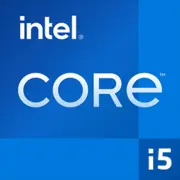Intel Core i5-3350P

Intel Core i5-3350P: Overview and Recommendations for PC Building in 2025
Is Ivy Bridge architecture still relevant? Let's take a look at this processor for budget systems.
1. Key Specifications: Architecture, Process Technology, Performance
The Intel Core i5-3350P processor, released in 2012, belongs to the third generation of Intel Core (codename Ivy Bridge). It is built on a 22nm process technology using 3D Tri-Gate transistors, which allowed for reduced power consumption and improved performance by 10-15% compared to the previous generation (Sandy Bridge).
Key parameters:
- 4 cores / 4 threads (no Hyper-Threading).
- Base frequency: 3.1 GHz, maximum Turbo Boost: 3.3 GHz.
- TDP: 69 W (low for its time).
- L3 cache: 6 MB.
- No integrated graphics (the "P" series is intended for systems with a discrete graphics card).
Performance:
According to Geekbench 6 (2025), the processor scores 579 points in single-core and 1707 in multi-core tests. This level is sufficient for basic tasks (office work, browsing, light gaming) but inadequate for modern AAA titles or resource-intensive applications.
Key features of Ivy Bridge:
- Support for PCIe 3.0 (relevant for NVMe SSDs via an adapter).
- Improved power management.
- Intel Quick Sync Video technology (hardware acceleration for video encoding, but requires an integrated GPU which is not present here).
2. Compatible Motherboards: Sockets and Chipsets
The processor uses the LGA 1155 socket, which is supported by motherboards with chipsets:
- H61, B75, H77, Z75, Z77.
Recommendations for 2025:
- For budget builds: Motherboards with H61 or B75 (cost on the second-hand market: $20–$40). They support up to 16–32 GB of DDR3, SATA II/III, but lack overclocking capabilities.
- For enthusiasts: Motherboards with Z77 (e.g., ASUS P8Z77-V) allow CPU overclocking using multipliers, but the i5-3350P has a locked multiplier. Such boards are valued for USB 3.0 and RAID support.
Important:
- Update your motherboard BIOS to the latest version for compatibility.
- Check for SATA III (6 Gb/s) and USB 3.0 ports if you plan to use SSDs or external drives.
3. Supported Memory Types
The i5-3350P works only with DDR3:
- Frequencies: 1066–1600 MHz (officially), but some boards support overclocking up to 1866 MHz.
- Maximum capacity: 32 GB (depends on the motherboard).
- Mode: Dual-channel (it is recommended to install two or four modules).
Tip:
Use DDR3-1600 for optimal performance. For example, a 16 GB kit (2x8 GB) will cost about $25–$35 on the second-hand market.
4. Power Supply Recommendations
With a TDP of 69 W and no integrated graphics, the processor does not require a powerful PSU. However, your choice depends on the graphics card:
- Without a discrete GPU: A PSU rated at 300–350 W is sufficient (e.g., be quiet! Pure Power 11 350W, $45).
- With a graphics card like the GTX 1650: A PSU rated at 400–450 W (EVGA 450 BR, $50).
- For GPUs like the RTX 3050: A PSU rated at 500–550 W (Corsair CX550M, $70).
Important:
Do not skimp on the PSU. Choose models with an 80 Plus Bronze certification or higher.
5. Pros and Cons of Intel Core i5-3350P
Pros:
- Low power consumption (suitable for compact builds).
- Adequate performance for office tasks and light gaming.
- Low second-hand price ($15–$25).
Cons:
- No Hyper-Threading (underperforms in multi-threaded tasks).
- Outdated platform (DDR3, PCIe 3.0).
- Lack of integrated graphics (requires a discrete GPU).
6. Use Cases
Gaming:
- CS:GO, Dota 2, Minecraft — 60+ FPS on medium settings (when paired with a GPU like the GTX 1050 Ti).
- Cyberpunk 2077, Starfield — not recommended: low clock speed and lack of multi-threading.
Work Tasks:
- Office applications, web browsers with 10+ tabs — no issues.
- Video editing or 3D rendering — too slow (better to consider Ryzen 5 5500).
Multimedia:
- Streaming video (4K via YouTube), media servers — handles it well.
7. Comparison with Competitors
- AMD FX-6300 (2012): 6 cores, but weak IPC. In games, the i5-3350P is about 20% faster.
- Intel Core i3-12100 (2023): 3 times higher performance in single-threaded tasks.
- Ryzen 5 5600G (2021): Integrated Vega 7 graphics, support for DDR4 — a clear favorite for budget builds in 2025.
Conclusion: The i5-3350P lags behind modern CPUs but excels in price for upgrading old PCs.
8. Practical Building Tips
1. SSD is a must: Install a SATA III SSD (e.g., Samsung 870 EVO 500GB, $50) to speed up the system.
2. Graphics Card: Choose models with low power consumption (GTX 1650, RX 6400).
3. Cooling: Even the stock cooler will suffice, but for quieter operation, a DeepCool Gammaxx 400 ($20) is a good fit.
4. Check Compatibility: Ensure the motherboard supports Ivy Bridge (not all LGA 1155 boards are compatible!).
9. Final Conclusion: Who Should Consider the i5-3350P in 2025?
This processor is suitable for:
- Upgrading old PCs (if you already have an LGA 1155 motherboard).
- Budget office systems (paired with an entry-level GPU).
- Media centers (for viewing 4K content).
Why not?
For new builds, it’s better to opt for modern platforms (AM5, LGA 1700) with support for DDR5 and PCIe 5.0.
Cost Consideration:
A complete build with the i5-3350P, 16 GB DDR3, GTX 1650, and SSD will cost around $200–$250 (on the second-hand market), making it one of the most affordable options for basic tasks.
If you're looking for a temporary solution or want to breathe new life into an old computer, the i5-3350P can still serve you well. However, for future upgrades, consider looking into newer generations.
Basic
CPU Specifications
Memory Specifications
Miscellaneous
Benchmarks
Compared to Other CPU
Share in social media
Or Link To Us
<a href="https://cputronic.com/cpu/intel-core-i5-3350p" target="_blank">Intel Core i5-3350P</a>